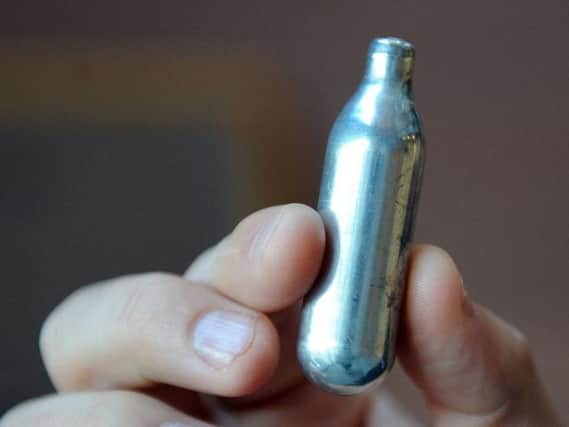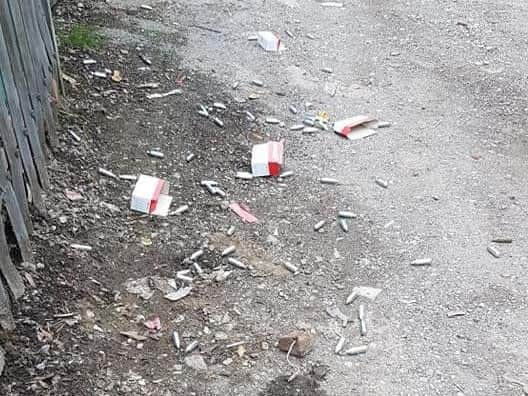Special report: Laughing gas use on the up in Wigan borough


Over the past year there have been increasing reports to Wigan Today, of teenagers taking nitrous oxide and leaving the evidence scattered at sites across the borough.
According to the Global Drug Survey, there was an 11 per cent increase in people inhaling the “psychedelic” drug, which is more commonly used as a painkiller in dentists and for women during childbirth.
Advertisement
Hide AdAdvertisement
Hide AdIt is now listed in the top 10 most commonly used drugs in the world.


Over the past six months there has been a marked increase in reports from borough residents finding discarded silver canisters which contain the gas.
Last month Wigan wildlife group “Friends of Three Sisters” reported finding in excess of 2,000 spent canisters over several weeks.
The volunteers said that in one instance more than 500 of the tubes had been left at the Bryn nature reserve overnight, sparking them to ask parents to keep an eye on their youngsters.
Advertisement
Hide AdAdvertisement
Hide AdMore recently, residents have reported finding canisters “all over Ashton”, with eyewitnesses saying that they have seen teens taking the drug whilst walking down Gerard Street, the main road through the town.
People have taken to social media to discuss the problem.
One Facebook user said: “It’s so awful to think that kids are doing this the evidence is gathering in the same spots around ashton. The police must know this.”
Haigh Hall Country Park has also reportedly become a hotspot for laughing gas use, with walkers snapping pictures of the canisters littering the woodland floor.
One nature lover, who helps to clean up the site, contacted the Wigan Post to shine a light on the issue.
Advertisement
Hide AdAdvertisement
Hide Ad“It’s an absolute disgrace,” they said. “Not content with taking this laughing gas and causing an absolute nuisance with their noise and behaviour, they think it is acceptable to toss their empty canisters into the stream.
“I’m sick of seeing them in the water around Haigh, areas people have worked hard to clean-up. And as fast as we remove the canisters, more are thrown in.
“Goodness knows what it is going to be like once the school holidays begin.”
David Gray, Wigan Council manager for crisis intervention and prevention, said: “We are working across the borough, with our partners and in schools, to remind young people of the dangers and risks association with using nitrous oxide.
Advertisement
Hide AdAdvertisement
Hide Ad“There are a number of side effects which can happen from regular use including red blood cell problems, that could result in anaemia, a risk of vitamin D deficiency with continued use and a link with mood swings and depression.
“We would encourage a referral to Addaction, for either adults or young people, for anyone requiring support with substance issues.”
How is it taken?
Laughing gas, aka nitrous oxide, is taken by inhalation.
Users typically transfer the gas from the canister to a balloon using a dispenser.
Once the nitrous oxide is inside the balloon, the user inhales it. Frank, one of the UK’s biggest drug helpline, warns that laughing gas can be fatal if it is inhaled directly from the dispenser as it can damage the lungs.
What does it do?
Advertisement
Hide AdAdvertisement
Hide AdShortly after inhaling the gas, users may feel the following symptoms. These symptoms generally can last up to a few minutes:
- euphoria
- numbness of the body
- sedation
- giddiness
- uncontrolled laughter
- uncoordinated movements
- blurred vision
- confusion
- dizziness
- light-headedness
- sweating
- feeling unusually tired
How much does it cost?
The laughing gas canisters can be bought through online shops selling them to make whipped cream.
A box of 48 canisters can be purchased for around £17, costing the user roughly 35p to 40p per unit.
The dispensers are priced from around £10 upwards.
The canisters and dispensers can be bought online from various websites, many of which say that there is an age limit of 18 or over to purchase.
What are the risks?
Advertisement
Hide AdAdvertisement
Hide AdAccording to Frank, the UK’s biggest drug advice help line, people have died after inhaling laughing gas.
The organisation states that it is “very dangerous” to inhale the gas directly from a canister.
Experts say that taking the drug in an enclosed space, such as a car, is also “very dangerous”.
They have given the following advice: “Never place a plastic bag over your head.
Advertisement
Hide AdAdvertisement
Hide Ad“If you take too much nitrous oxide you risk falling unconscious and/or suffocating from the lack of oxygen. People have died this way.
“Heavy regular use of nitrous oxide can lead to a deficiency of vitamin B12 and to a form of anaemia. Severe B12 deficiency can lead to serious nerve damage, causing tingling and numbness in the fingers and toes.
“This can be very painful and make walking difficult. Regular use can stop you forming white blood cells properly.
“It can be hard to judge the amount to use safely. If you have too much you can end up fainting, having an accident or worse.”
Advertisement
Hide AdAdvertisement
Hide AdThe organisation says that there have been reports of people becoming “psychologically dependent” on the drug.
It also warns against mixing laughing gas with alcohol, as the combination can heighten the effects of both substances, sometimes causing harmful side effects.
What is the law?
Supplying nitrous oxide canisters for recreational purposes is an offence under the Psychoactive Substances Act 2016.
This means that people will commit an offence even if they give a canister of nitrous oxide to a friend.
Advertisement
Hide AdAdvertisement
Hide AdAnyone found to be selling or giving away nitrous oxide for illicit purposes could face up to seven years in prison and or an unlimited fine.
Last year, Wigan’s neighbourhood policing teams said that they are continuing to work with schools regarding the “increasing use” of nitrous oxide in the borough.